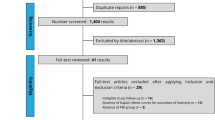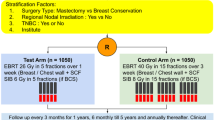Abstract
Purpose
Breast conservation therapy (BCT) for early-stage breast cancer involves lumpectomy followed by whole breast radiotherapy, which can involve either standard fractionation (SRT) or accelerated fractionation (ART). This systematic review and meta-analysis was performed to determine whether any benefit exists for ART or SRT.
Materials and methods
We searched MEDLINE (1966–2014), all seven databases of the Cochrane Library (1968–2014), EMBASE (1974–2014), clinicaltrials.gov, ISRCTN, WHO ICTRP, and meeting abstracts in the Web of Science Core Collection (1900–2014). RCTs comparing SRT to ART among women undergoing BCT with stage T1–T2 and/or N1 breast cancer or carcinoma in situ were included. Follow-up was 30 days for acute toxicity, or three years for disease control and late toxicity.
Results
13 trials with 8189 participants were included. No differences were observed in local failure (n = 7 trials; RR 0.97; 95% CI 0.78–1.19, I 2 = 0%), locoregional failure, (n = 8 trials; RR 0.86; 95% CI 0.63–1.16, I 2 = 0%), or survival (n = 4 trials; RR 1.00; 95% CI 0.85–1.17, I 2 = 0%). ART was associated with significantly less acute toxicity (n = 5 trials; RR 0.36; 95% CI 0.21–0.62, I 2 = 20%), but no difference in late cosmesis (RR 0.95; 95% CI 0.81–1.12, I 2 = 54%).
Conclusions
ART use does not reduce disease control or worsen long-term cosmetic outcome, and may decrease the risk of acute radiation toxicity as compared to SRT.




Similar content being viewed by others
References
Siegel RL, Miller KD, Jemal A (2016) Cancer statistics, 2016. CA Cancer J Clin 66:7–30. doi:10.3322/caac.21332
Kohler BA, Sherman RL, Howlader N et al (2015) Annual report to the nation on the status of cancer, 1975–2011, featuring incidence of breast cancer subtypes by race/ethnicity, poverty, and state. J Natl Cancer Inst 107:djv048. doi:10.1093/jnci/djv048
Early Breast Cancer Trialists’ Collaborative Group, Darby S, McGale P et al (2011) Effect of radiotherapy after breast-conserving surgery on 10-year recurrence and 15-year breast cancer death: meta-analysis of individual patient data for 10,801 women in 17 randomised trials. Lancet 378:1707–1716
Baillet F, Housset M, Maylin C et al (1990) The use of a specific hypofractionated radiation therapy regimen versus classical fractionation in the treatment of breast cancer: a randomized study of 230 patients. Int J Radiat Oncol Biol Phys 19:1131–1133
Whelan TJ, Pignol J, Levine MN et al (2010) Long-term results of hypofractionated radiation therapy for breast cancer. N Engl J Med 362:513–520
Bekelman JE, Sylwestrzak G, Barron J et al (2014) Uptake and costs of hypofractionated vs conventional whole breast irradiation after breast conserving surgery in the United States, 2008–2013. JAMA 312:2542–2550
Liberati A, Altman DG, Tetzlaff J et al (2009) The PRISMA statement for reporting systematic reviews and meta-analyses of studies that evaluate health care interventions: explanation and elaborationprisma: explanation and elaboration. PLoS Med 151:65
Higgins JP, Altman DG, Gotzsche PC et al (2011) The cochrane collaboration’s tool for assessing risk of bias in randomised trials. BMJ 343:d5928. doi:10.1136/bmj.d5928
Nordic Cochrane Centre The Cochrane Collaboration (2014) Review manager (RevMan)[computer program] Version 53. The Nordic Cochrane Centre, The Cochrane Collaboration, Copenhagen
Van Parijs H, Miedema G, Vinh-Hung V et al (2012) Short course radiotherapy with simultaneous integrated boost for stage I-II breast cancer, early toxicities of a randomized clinical trial. Radiat Oncol 7:80
Li S, Wang S, Song Y et al (2014) Interim analysis of 354 breast cancer patients randomly treated with hyperfractionated or conventional fractionated radiation therapy after breast-conserving surgery. Int J Radiat Oncol Biol Phys 90:S256
Medicine ABoI (2003) Choosing wisely: five things physicians and patients should question
Anonymous (2013) Accelerated radiotherapy after breast-conserving surgery for early stage breast cancer. 27:1–6
Hickey BE, James ML, Lehman M et al (2016) Fraction size in radiation therapy for breast conservation in early breast cancer. Cochrane Libr 7:CD003860
Zhou Z, Mei X, Chen X et al (2015) Systematic review and meta-analysis comparing hypofractionated with conventional fraction radiotherapy in treatment of early breast cancer. Surg Oncol 24:200–211
Smith BD, Bentzen SM, Correa CR et al (2011) Fractionation for whole breast irradiation: an American Society for Radiation Oncology (ASTRO) evidence-based guideline. Int J Radiat Oncol Biol Phys 81:59–68
Whelan T, Pignol J, Julian J et al (2008) Long-term results of a randomized trial of accelerated hypofractionated whole breast irradiation following breast conserving surgery in women with node-negative breast cancer. Int J Radiat Oncol Biol Phys 72:S28
Spooner D, Stocken DD, Jordan S et al (2012) A randomised controlled trial to evaluate both the role and the optimal fractionation of radiotherapy in the conservative management of early breast cancer. Clin Oncol 24:697–706
Jagsi R, Griffith KA, Boike TP et al (2015) Differences in the acute toxic effects of breast radiotherapy by fractionation schedule: comparative analysis of physician-assessed and patient-reported outcomes in a large multicenter cohort. JAMA Oncol 1:918–930
Hall EJ, Giaccia AJ (2006) Radiobiology for the radiologist. Lippincott Williams and Wilkins, Philadelphia
Haviland JS, Owen JR, Dewar JA et al (2013) The UK Standardisation of Breast Radiotherapy (START) trials of radiotherapy hypofractionation for treatment of early breast cancer: 10-year follow-up results of two randomised controlled trials. Lancet Oncol 14:1086–1094
DeSantis C, Ma J, Bryan L et al (2014) Breast cancer statistics. CA 64:52–62
Smith BD, Haffty BG, Wilson LD et al (2010) The future of radiation oncology in the United States from 2010 to 2020: will supply keep pace with demand? J Clin Oncol 28:5160–5165. doi:10.1200/JCO.2010.31.2520
Schroen AT, Brenin DR, Kelly MD et al (2005) Impact of patient distance to radiation therapy on mastectomy use in early-stage breast cancer patients. J Clin Oncol 23:7074–7080. doi:10.1200/JCO.2005.06.032
Barsoum M, El Mongi M, Khalil E, Eisa H, Hamed I, Attia G (2010) Prospective randomized trial comparing postoperative adjuvant concurrent versus sequential hormonal and different radiation fractionation schedule in breast cancer patients. J Clin Oncol 28(15_suppl):544
Fragandrea I, Kouloulias V, Sotiropoulou A, Gouliamos A, Kouvaris I (2012) 395 radiation induced skin toxicity following hypofractionated radiotherapy treatment in early breast cancer: single institution experience. Eur J Cancer 48:S158
Fragkandrea-Nixon I (2013) Radiation-induced lung and heart toxicity in patients with early-stage breast cancer treated with hypofractionated radiotherapy following breast-conservative surgery. J Clin Oncol 31(26_suppl):73
Fragkandrea-Nixon I, Kouloulias V, Mpaziotis N et al (2011) Preliminary results on the impact of hypofractionated radiotherapy in cardiac toxicity (cardiac function) in early staged left sided breast cancer patients: a prospective randomized phase ii study. Radiother Oncol 98:S41
Fragkandrea I, Kouloulias V, Mavridis P et al (2013) Radiation induced pneumonitis following whole breast radiotherapy treatment in early breast cancer patients treated with breast conserving surgery: a single institution study. Hippokratia 17(3):233–238
Fragandrea I, Zetos A, Georgolopoulou P et al (2009) 5127 hypofractionation versus conventional fractionation radiotherapy (RT) after breast conservative treatment of breast cancer: radiation induced pneumonitis. Eur J Cancer Suppl 7(2):297–298
Haislund B, Bang T, Ellegaard MB, Offersen B (2012) Po-0954 acute morbidity in patients with early breast cancer in adjuvant radiotherapy in the dbcg hypo and dbcg pbi protocols. Radiother Oncol 103(Supplement 1):S375–S376. doi:10.1016/S0167-8140(12)71287-2
Bentzen SM, Agrawal RK, Aird EG et al (2008) The UK standardisation of breast radiotherapy (START) trial A of radiotherapy hypofractionation for treatment of early breast cancer: a randomised trial. Lancet Oncol 9:331–341
Hopwood P, Haviland JS, Sumo G, Mills J, Bliss JM, Yarnold JR (2010) Comparison of patient-reported breast, arm, and shoulder symptoms and body image after radiotherapy for early breast cancer: 5-year follow-up in the randomised standardisation of breast radiotherapy (START) trials. Lancet Oncol 11(3):231–240. doi:10.1016/S1470-2045(09)70382-1
Bentzen SM, Agrawal RK, Aird EG et al (2008) The UK standardisation of breast radiotherapy (START) trial B of radiotherapy hypofractionation for treatment of early breast cancer: a randomised trial. Lancet 371:1098–1107
Karmacharya R, Shah A, Jha A, Shrestha S, Pandit S (2012) A comparative study of acute toxicity between conventional and hypofractionated adjuvant radiotherapy in breast cancer. J Cancer Res Ther 8:S145
Patni N, Jain M, Patni S, Bapna A (2012) A comparison of acute and chronic toxicity profile between conventional and hypofractionated whole breast irradiation in patients undergoing breast conserving surgery. Int J Radiat Oncol Biol Phys 84(3):S232
Saha S, Dastidar AG, Gangopadhyay A, Ghorai S (2009) Evaluation of hypofractionated adjuvant radiotherapy for early breast cancer: a prospective randomized study. Int J Radiat Oncol Biol Phys 75(3):S76
Whelan T, MacKenzie R, Levine M, ShelleyW JJ, Grimard L (2000) A randomized trial comparing two fractionation schedules for breast irradiation postlumpectomy in node-negative breast cancer. J Natl Cancer Inst 19:2a
Brunt A, Sydenham M, Bliss J et al (2009) 7LBA A 5-fraction regimen of adjuvant radiotherapy for women with early breast cancer: first analysis of the randomised UK FAST trial (ISRCTN62488883, CRUKE/04/015). Eur J Cancer Suppl 7(3):2
Yarnold J, Owen R, Ashton A et al (2001) Fractionation sensitivity of change in breast appearance after radiotherapy for early breast cancer: Results of a phase III randomised trial. Breast Cancer Res Treat 69(3):230
Agrawal RK, Alhasso A, Barrett-Lee PJ et al (2011) First results of the randomised UK FAST trial of radiotherapy hypofractionation for treatment of early breast cancer (CRUKE/04/015). Radiother Oncol 100:93–100
Yarnold J, Owen J, Bliss J et al (1993) Randomised comparison of a 13 fraction schedule with a conventional 25 fraction schedule of radiotherapy after local excision of early breast cancer: preliminary analysis. Breast 2(3):201
Owen JR, Ashton A, Bliss JM et al (2006) Effect of radiotherapy fraction size on tumour control in patients with early-stage breast cancer after local tumour excision: long-term results of a randomised trial. Lancet Oncol 7(6):467–471
Owen J, Haviland J, Agrawal R et al (2007) 2026 ORAL results of the UK standardisation of breast radiotherapy (START) trials testing hypofractionation for early breast cancer–on behalf of the START trials centres. Eur J Cancer Suppl 5(4):191–192
Author information
Authors and Affiliations
Corresponding author
Ethics declarations
Conflict of interest
The authors declare that they have no conflict of interest.
Human and animal rights
This article does not contain any studies with human participants or animals performed by any of the authors.
Rights and permissions
About this article
Cite this article
Valle, L.F., Agarwal, S., Bickel, K.E. et al. Hypofractionated whole breast radiotherapy in breast conservation for early-stage breast cancer: a systematic review and meta-analysis of randomized trials. Breast Cancer Res Treat 162, 409–417 (2017). https://doi.org/10.1007/s10549-017-4118-7
Received:
Accepted:
Published:
Issue Date:
DOI: https://doi.org/10.1007/s10549-017-4118-7




